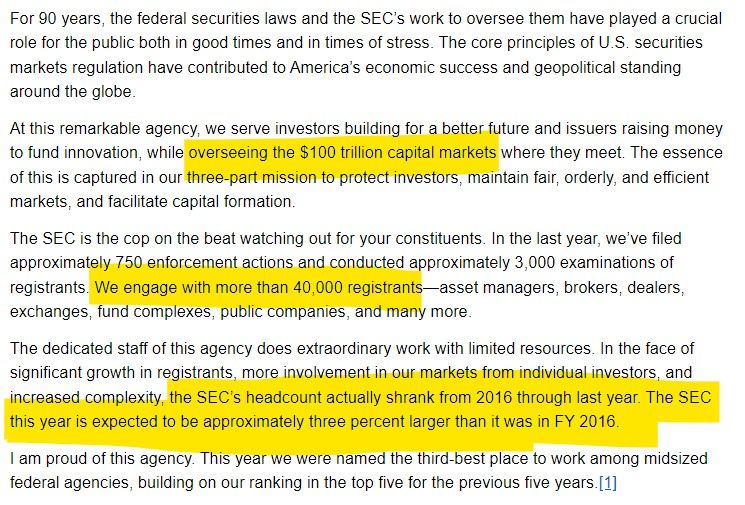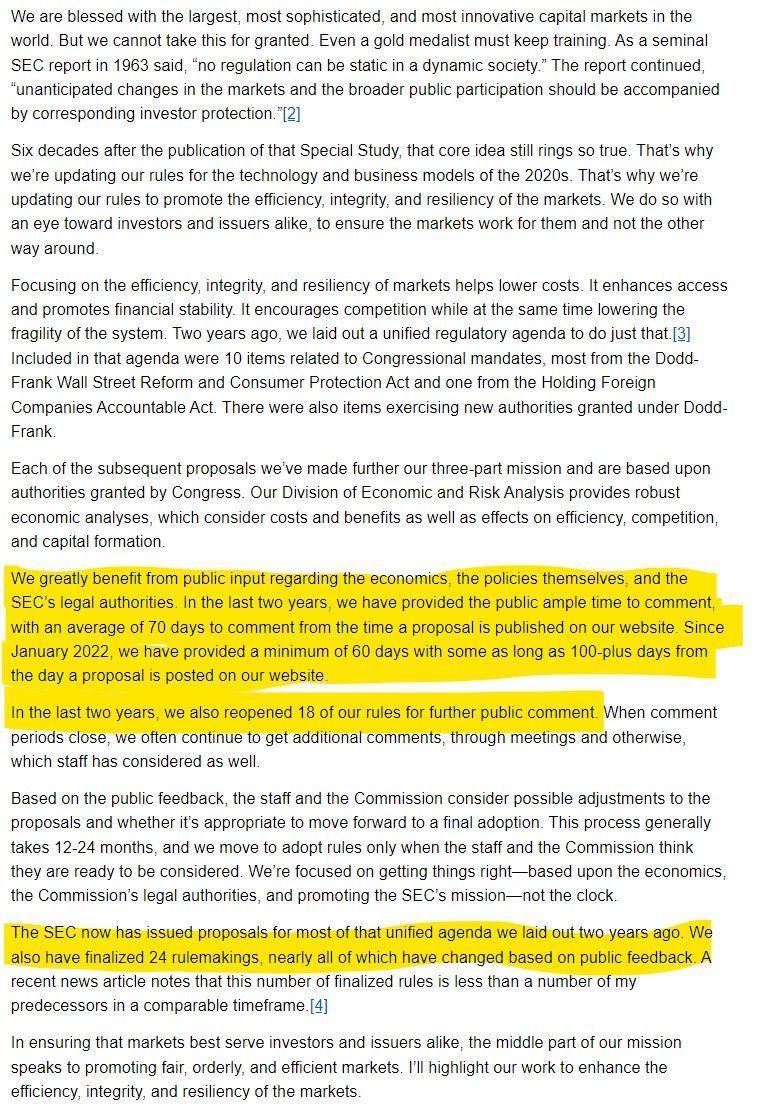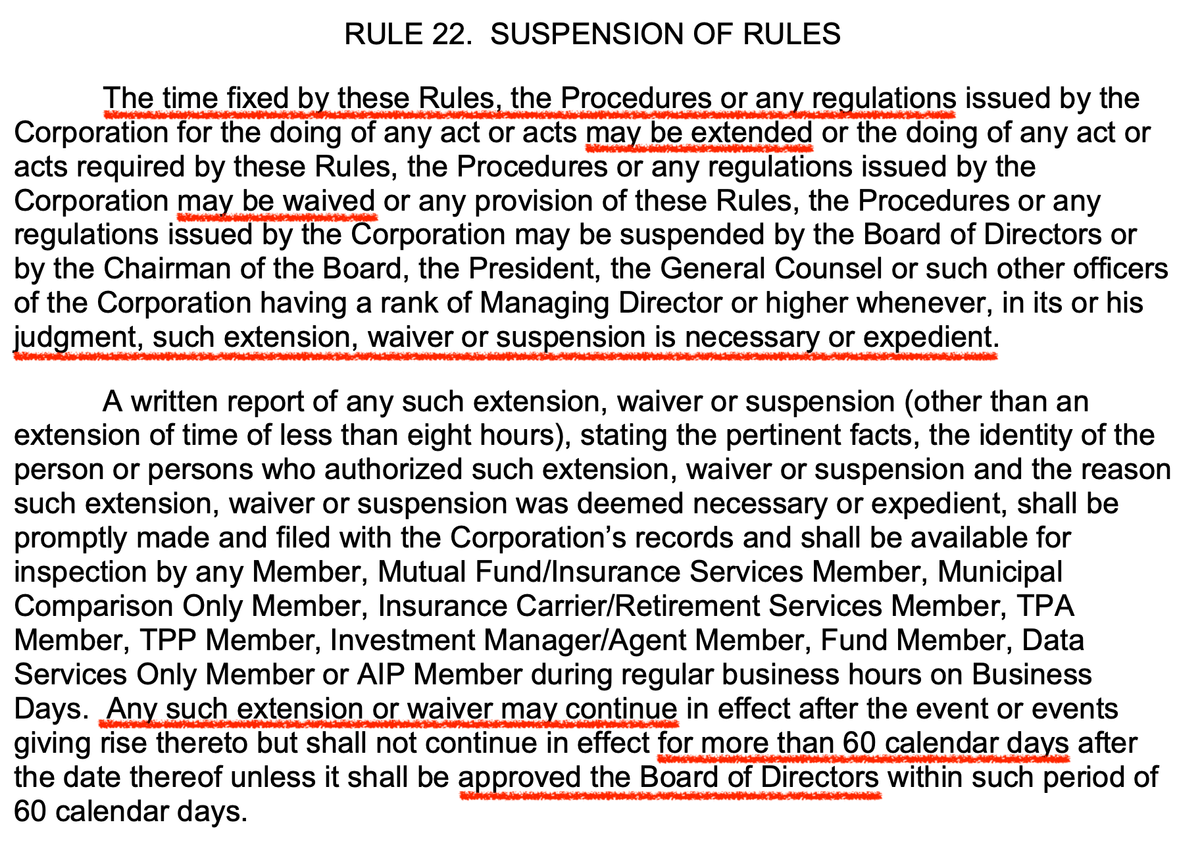Gary Gensler: "The SEC now has issued proposals for most of that unified agenda we laid out two years ago." "I will not be able to comment on any active, ongoing litigation."

With Citadel telling peers it is ready to fight the SEC, Members of Congress introducing bills to fire him, and serious efforts behind closed doors to block the SEC's agenda, I thought it would be helpful to review Gary's testimony before the Financial Services Committee for clues as to why all these folks are so mad.
So... What did he say?
Protecting the Public for 90 Years:

It would seem industry could be upset by the SEC increasing headcount to being as big and bigger than it was 7 years ago?
Updating Our Rules to Meet the Challenges of Our Time:

Could industry be upset the SEC is making progress on its unified agenda?
Efficiency and Competition (This is the stuff that seems to have them all worked up):
Congress both in the 1970s and again in the 1990s updated the securities laws, giving the SEC a specific role to promote competition and efficiency. In particular in 1996, Congress mandated that, in addition to investor protection and public interest, the SEC consider efficiency and competition, as well as capital formation, in formulating our rules.[5] Congress understood that lowering the cost in the middle of our capital markets would help lower costs for issuers and raise returns for investors.
In that context, we have put out to public comment proposals regarding securities lending,[6] short sale disclosures,[7] and large position reporting for securities-based swaps.[8]
I will take a moment to elaborate on our work in equity markets and private funds.
Equity Markets
With some 68 million American households investing in the equity markets,[9] these markets are critical to issuers and investors alike. These markets also are experiencing rapidly changing technology. Thus, it’s appropriate that the SEC freshen up its rules to promote efficiency and competition in the more than $40 trillion equity markets.
Key aspects of our rules for the national market system haven’t been updated since 2005. Yet so much has changed. Not only have we seen the electrification of markets, but also a significant share of the markets has moved to wholesalers and other means of trading off exchange, otherwise known as the dark markets.
First, we issued for public comment a proposal that broker-dealers meet a Commission best execution standard—in essence, that broker-dealers seek the best execution for investors when they buy or sell securities. As proposed, this rule would cover all sectors of the securities markets, including equity, fixed-income, and crypto asset securities.[10]
Second, we proposed updating a 23-year-old rule, known as Rule 605, on disclosure of order execution quality.[11]
Third, we have a proposal to better level the playing field between dark and lit markets. We are seeking to harmonize the minimum price increment where stocks can be quoted and transacted as well as lower these minimum increments across the markets.[12]
Lastly, we put out a proposal to bring greater competition for a segment of the market related to individual investors’ marketable orders.[13]
Private Funds
Last month, we finalized a rule that, among other things, will require private fund advisers registered with the Commission to provide detailed disclosure to investors regarding fees, expenses, and performance.[14] Further, the rule addressed certain sales practices, conflicts, and compensation schemes of advisers to private funds. Enhancing advisers’ transparency and integrity promotes greater competition and thereby efficiency in this important part of the markets.
Private funds and their advisers play a significant role for investors and issuers. They play an important role in nearly every sector of the capital markets. On one side are the funds’ investors, such as retirement plans or endowments. Standing behind those entities are millions of investors like municipal workers, teachers, firefighters, professors, students, and more. On the other side are issuers raising capital from private funds, ranging from startups to late-stage companies.
After the 2008 financial crisis, Congress understood the important role that private funds and advisers play. In the Dodd-Frank Act of 2010, Congress effectively required most private fund advisers to register with the Securities and Exchange Commission. Congress also gave the Commission specific new authorities under the Investment Advisers Act of 1940 to prohibit or restrict advisers’ sales practices, conflicts, and compensation schemes.[15] This built upon our existing authorities to regulate advisers with respect to their books and records as well as with respect to fraudulent, deceptive, or manipulative practices, among others.[16]
The final rule was adjusted in multiple ways based on public feedback on the proposal.[17]
Integrity and Disclosure (more of what they hate):
Market integrity and disclosure help protect investors and build trust in capital markets. Such trust helps lower the cost of capital for issuers and enhance returns for investors. It also helps increase participation in the capital markets. This is good for those investing for their future and for issuers. Integrity and disclosure facilitate what can be the best of capital markets and guard against the worst.
In this context, we have completed rules related to how insiders trade and sell their stock;[18] clawing back senior executives’ compensation when based on faulty financials;[19] disclosure of executive pay versus performance;[20] stock buyback disclosures;[21] fraud and manipulation in the security-based swaps market;[22] as well as investment fund names.[23]
We also have issued proposals with regard to special purpose acquisition companies,[24] beneficial ownership disclosure,[25] and funds and advisers that incorporate environmental, social, and governance factors.[26]
In the wake of the Bernie Madoff scandal, Congress in the Dodd-Frank Act gave the SEC updated authorities that investment advisers should safeguard all client assets over which they have custody—not just funds or securities. Thus, earlier this year, the Commission proposed to expand and enhance the role of qualified custodians when registered investment advisers custody assets on behalf of their investors.[27]
I’m going to discuss two areas of emerging technology, predictive data analytics and crypto, and then turn to two issuer disclosure rules regarding climate and cyber risks.
Artificial Intelligence and Predictive Data Analytics
We live in an historic, transformational age regarding predictive data analytics and the use of artificial intelligence. As we further automate pattern recognition and parts of human intelligence itself, this can create great efficiencies across the economy.
Today’s predictive data analytics models also provide an increasing ability to make predictions about each of us as individuals. Such analytics and narrowcasting have the potential benefits of greater financial inclusion and enhanced user experience.
This also raises the possibilities that conflicts may arise to the extent, for example, that advisers or broker-dealers are optimizing to place their interests ahead of their investors’ interests. If a firm’s optimization function takes the interest of the firm into consideration as well as the interest of the investor, this can lead to conflicts of interest.
In July, we put out a proposal to require firms to analyze conflicts of interest that may emerge when using predictive data analytics to interact with investors.[28] Firms would need to identify any such conflicts that result in an investor interaction that places the firm’s interests ahead of investors’ interests. Firms then would need to eliminate or neutralize the effects of those conflicts.
Crypto
There is nothing about the crypto asset securities markets that suggests that investors and issuers are less deserving of the protections of our securities laws.
Congress could have said in 1933 or in 1934 that the securities laws applied only to stocks and bonds. Yet Congress included a long list of 30-plus items in the definition of a security, including the term “investment contract.” As I’ve previously said, without prejudging any one token, the vast majority of crypto tokens likely meet the investment contract test.
Given that most crypto tokens are subject to the securities laws, it follows that most crypto intermediaries have to comply with securities laws as well.
These laws have been on the books for decades. Sections 5, 15(a), and 17A(b) of the Securities Exchange Act of 1934 require that intermediaries acting as securities exchanges, brokers and dealers, and clearing agencies are subject to the securities laws, and must register or satisfy requirements for an exemption.
Given this industry’s wide-ranging noncompliance with the securities laws, it’s not surprising that we’ve seen many problems in these markets. We’ve seen this story before. It’s reminiscent of what we had in the 1920s before the federal securities laws were put in place.
Thus, we have brought a number of enforcement actions—some settled, and some in litigation—to hold wrongdoers accountable and promote investor protection.
The SEC also has addressed the crypto security markets through rulemaking. We issued a reopening release that reiterated the applicability of existing rules to platforms that trade crypto asset securities, including so-called “DeFi” systems. This release also provided supplemental information for systems that would be included in a new, proposed exchange definition.[29]
While our current investment adviser custody rule already applies to crypto funds and securities, our proposal updating it would cover all crypto assets and enhance the protections that qualified custodians provide.[30]
These are just two examples of the rules we’ve proposed that touch the crypto markets.
While I’m happy to discuss the SEC’s work, I will not be able to comment on any active, ongoing litigation.
Resiliency
History is replete with times when fires in one corner of the financial system or at one financial institution spread to the broader economy. When this happens, the American public inevitably gets hurt.
Such fires, though too many to name, have started from both the banking and nonbanking sectors.
The financial fires of 2008 led to more than eight million Americans losing their jobs, millions of families losing their homes, and small businesses across the country folding.
Promoting financial resiliency goes to the core of the SEC’s three-part mission. It’s the essence of fair, orderly, and efficient markets. In normal times, it helps promote trust in capital markets. In times of stress, it protects investors and issuers alike.
Thus, I’m proud that the SEC has taken up a number of projects to enhance the resiliency of our capital markets.
We already finalized a rule to shorten the settlement cycle in securities markets in half, which lowers risk and promotes efficiency as well as greater liquidity in the markets.[34] We also finalized a rule to enhance cross-market and off-exchange oversight for some of the most active participants in the capital markets.[35]
We have proposals with regard to clearinghouse governance, risk management, use of service providers, and recovery and wind-down plans.[36]
We also have proposals related to cybersecurity and technological resiliency in the financial sector.[37]
Separately, we also put out proposals for public comment on open-end fund liquidity.[38]
I’d like to take a moment to elaborate on our work on Treasury markets, money market funds, and private funds.
Treasury Markets
The $25 trillion Treasury markets[39] are the base upon which so much of our capital markets are built. Myriad markets and financial products are priced off of treasuries. Treasuries are embedded in money market funds. They are integral to monetary policy. They are how we, as a government and as taxpayers, raise money: We are the issuer.
Though Roosevelt and Congress initially didn’t give the SEC a significant role in the Treasury markets, market events and failures at government securities firms in the early 1980s led Congress to give us an important role with regard to these markets.[40] In normal times these markets function well, but they have had repeated moments of instability, whether the flash crash in 2014, problems in the Treasury funding markets in 2019, or the dash for cash in 2020. Events in the Treasury markets this year are yet again a reminder that even the vast Treasury markets can experience significant volatility and lessened liquidity.
All of this is why the SEC has worked with the Department of the Treasury, the Federal Reserve System, and other agencies to enhance the efficiency and resiliency of the Treasury markets.[41] These proposals include registering and regulating Treasury dealers and platforms, as well as facilitating greater clearing of treasuries in both cash and funding markets.[42]
Money Market Funds
In July, we adopted a rule to enhance money market funds’ liquidity and investor protection.[43] It will enhance these funds’ resiliency and ability to protect against dilution.
Money market funds—just more than $6 trillion in size today—provide millions of Americans with a deposit alternative to traditional bank accounts. Using these funds, shareholders can get market-based returns, fully backed dollar-for-dollar by readily marketable securities.
Money market funds, though, have a potential structural liquidity mismatch. Investors can redeem their money market fund holdings on a daily basis, even if those funds keep some of their holdings in securities with less liquidity.
As a result, when markets enter times of stress, some investors—fearing dilution or illiquidity—may try to escape the bear.[44] This can lead to large amounts of rapid redemptions. We have observed this play out in times of stress, including during the 2008 financial crisis and the “dash for cash” in March 2020. Left unchecked, such stress can undermine these critical funds.
Taking into account public comment, the final money market fund rules, as adopted, will require liquidity fees instead of the originally proposed swing pricing requirement. Liquidity fees, compared with swing pricing, offer many of the same benefits and fewer of the operational burdens.
Form PF
In response to the 2008 crisis, Congress mandated that the SEC and the Commodity Futures Trading Commission (CFTC), working with the member regulators of the Financial Stability Oversight Council (FSOC), establish reporting requirements for private funds “as necessary and appropriate in the public interest and for the protection of investors, or for the assessment of systemic risk.”[45] Thus, in 2011, along with the CFTC, we created Form PF, an important tool the Commission uses to oversee private fund advisers.
In the 12 years since we first adopted Form PF, private funds have evolved significantly in their business practices, complexity, and investment strategies. Private funds today are ever more interconnected with our broader capital markets.
Private funds nearly have tripled in size in the last decade to approximately $26 trillion[46] in gross assets. This compares to the U.S. commercial banking industry of approximately $23 trillion.[47] This makes visibility into these funds critical.
In May, we finalized a rule amending Form PF.[48]
Among other things, the final rule requires, for the first time, that large hedge fund and private equity fund advisers make current reports on certain events to the Commission. These new, more-timely reports—within 72 hours from large hedge fund advisers and quarterly from private equity fund advisers—will inform financial regulators on certain events that may indicate significant stress or otherwise signal for systemic risk or investor harm.
These amendments will improve visibility into private funds, helping protect investors and promote financial stability.
We also have a joint proposal with the CFTC to improve the quality of the information we receive from all Form PF filers, with a particular focus on large hedge fund advisers. The staffs of the SEC and CFTC are currently reviewing comments that we received on this proposal and are working on a potential joint recommendation for their respective commissions.
Recapping what has them 'mad':
- It would seem industry could be upset by the SEC increasing headcount to being as big and bigger than it was 7 years ago?
- The industry seems upset the SEC is making progress on its unified agenda?
This is the stuff that seems to have them all worked up:
- First, we issued for public comment a proposal that broker-dealers meet a Commission best execution standard—in essence, that broker-dealers seek the best execution for investors when they buy or sell securities. As proposed, this rule would cover all sectors of the securities markets, including equity, fixed-income, and crypto asset securities.[10]
- Second, we proposed updating a 23-year-old rule, known as Rule 605, on disclosure of order execution quality.[11]
- Third, we have a proposal to better level the playing field between dark and lit markets. We are seeking to harmonize the minimum price increment where stocks can be quoted and transacted as well as lower these minimum increments across the markets.[12]
- Lastly, we put out a proposal to bring greater competition for a segment of the market related to individual investors’ marketable orders.[13]
- Last month, we finalized a rule that, among other things, will require private fund advisers registered with the Commission to provide detailed disclosure to investors regarding fees, expenses, and performance.[14] Further, the rule addressed certain sales practices, conflicts, and compensation schemes of advisers to private funds. Enhancing advisers’ transparency and integrity promotes greater competition and thereby efficiency in this important part of the markets.
- In this context, we have completed rules related to how insiders trade and sell their stock;[18] clawing back senior executives’ compensation when based on faulty financials;[19] disclosure of executive pay versus performance;[20] stock buyback disclosures;[21] fraud and manipulation in the security-based swaps market;[22] as well as investment fund names.[23]
- We also have issued proposals with regard to special purpose acquisition companies,[24] beneficial ownership disclosure,[25] and funds and advisers that incorporate environmental, social, and governance factors.[26]
- In the wake of the Bernie Madoff scandal, Congress in the Dodd-Frank Act gave the SEC updated authorities that investment advisers should safeguard all client assets over which they have custody—not just funds or securities. Thus, earlier this year, the Commission proposed to expand and enhance the role of qualified custodians when registered investment advisers custody assets on behalf of their investors.[27]
- In July, we put out a proposal to require firms to analyze conflicts of interest that may emerge when using predictive data analytics to interact with investors.[28] Firms would need to identify any such conflicts that result in an investor interaction that places the firm’s interests ahead of investors’ interests. Firms then would need to eliminate or neutralize the effects of those conflicts.
- We issued a reopening release that reiterated the applicability of existing rules to platforms that trade crypto asset securities, including so-called “DeFi” systems. This release also provided supplemental information for systems that would be included in a new, proposed exchange definition.[29]
- While our current investment adviser custody rule already applies to crypto funds and securities, our proposal updating it would cover all crypto assets and enhance the protections that qualified custodians provide.[30]
- We already finalized a rule to shorten the settlement cycle in securities markets in half, which lowers risk and promotes efficiency as well as greater liquidity in the markets.[34] We also finalized a rule to enhance cross-market and off-exchange oversight for some of the most active participants in the capital markets.[35]
- We have proposals with regard to clearinghouse governance, risk management, use of service providers, and recovery and wind-down plans.[36]
- We also have proposals related to cybersecurity and technological resiliency in the financial sector.[37]
- Separately, we also put out proposals for public comment on open-end fund liquidity.[38]
- In July, we adopted a rule to enhance money market funds’ liquidity and investor protection.[43] It will enhance these funds’ resiliency and ability to protect against dilution.
- In May, we finalized a rule amending Form PF.[48]
- Among other things, the final rule requires, for the first time, that large hedge fund and private equity fund advisers make current reports on certain events to the Commission. These new, more-timely reports—within 72 hours from large hedge fund advisers and quarterly from private equity fund advisers—will inform financial regulators on certain events that may indicate significant stress or otherwise signal for systemic risk or investor harm.
TLDRS:
- With Citadel telling peers it is ready to fight the SEC, Members of Congress introducing bills to fire him, and serious efforts behind closed doors to block the SEC's agenda, I thought it would be helpful to review Gary Gensler's testimony before the Financial Services Committee for clues as to why all these folks are so mad.
- Gensler calls out 19 things the SEC is doing currently that has them up in arms!



